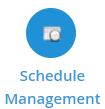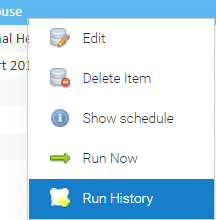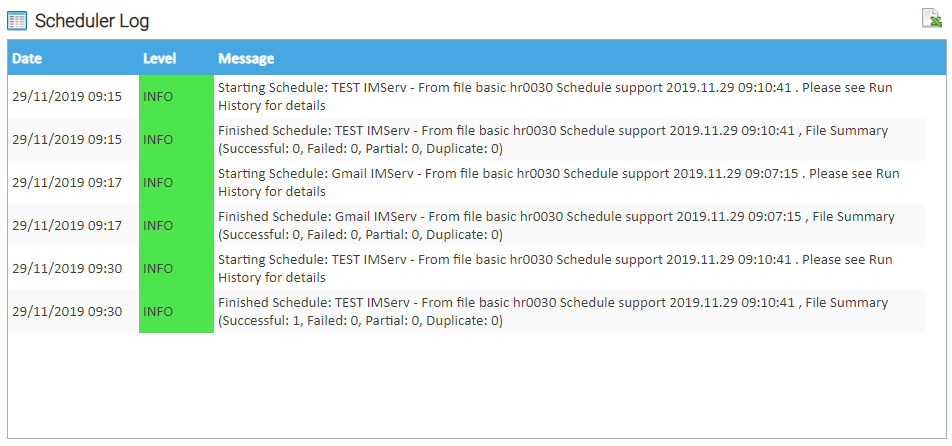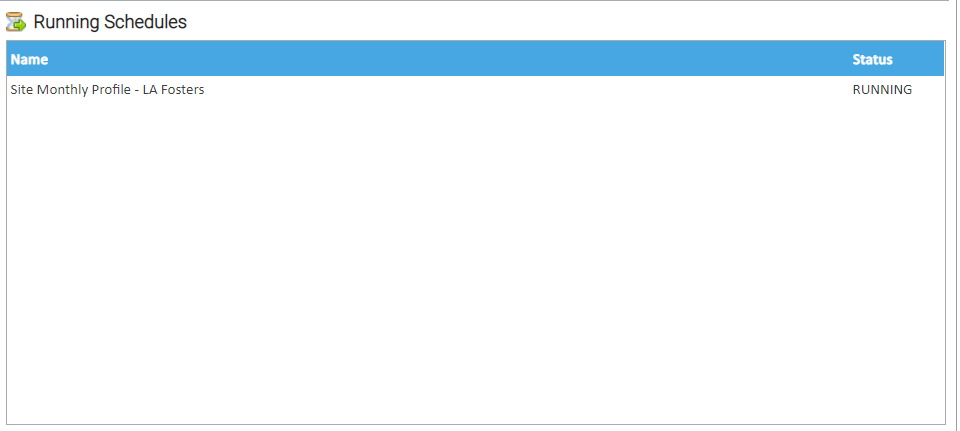...
Opening Schedule Management
To open the Activity, click :
- Click on the Schedule Management Activity
Schedule List section
...
- The name of the Schedule
- The date the schedule last ran
- The date the schedule is due to run next
- The type which represents how frequently the schedule has been configured to run, e.g. Daily or Monthly
- The status of the last Run
- Whether the Schedule is Active
- Whether the Schedule has an end date at which point it will stop running
...
| Info |
|---|
There are 7 columns available. These can be added/hidden by clicking on the downward arrow on the Column Header > clicking Columns and ticking or unticking |
...
There are three options at the top of the Activity:
- Include run once? - tick to include Schedules there were only set to run once (for instance, when running a Report to the Document Library as a one of action)
- Include inactive? - tick to include Schedules that have been disabled (for instance, a Report that is no longer required)
- Run History - Highlight a schedule to view the run history which shows information about the last 6 months of processing completed by the schedule. It will show each of times/dates the schedule has run and details of any failures to help diagnose any problems where the schedule has not run successfully.
Right Click Options
Right click on a Schedule, and you have the following options:
- Edit
- Delete Item
- Show Schedule
- Run Now
- Run History
Each of these options are explained in more detail below.:
Edit
- Right click > Click Edit
...
This allows you to view/edit the details of the Schedule such as the Name, Description, Configuration, Email Address, File Format, etc.
- If any changes are made, click OK
...
or
- Click Cancel to return to the Schedule Management Activity
...
Delete
- Right click > Delete
...
This will delete the Schedule are remove it from the list.
...
| Warning |
|---|
Please note that deleting a Schedule will also remove all run history information. If you want to maintain a history of information for a period of time, you are best setting the status to "Inactive". |
View Schedule
- Right click > Show Schedule
...
This will show the next 25 occurrences that are due to be triggered for the schedule - it will show the date and time of each one.
- Click OK to return to the Schedule Management Activity
...
Run Now
- Right click > Run Now
...
This is a manual override to run the Schedule (ahead of the next date and time it is automatically due to run). For example, you may have a Schedule to import your Half Hourly data. The schedule is set to collect the data on the 1st of the month, but the data hadn't wasn't sent to the email account until the 2nd. Instead of waiting for Sigma to import it the following month, click Run Now and the Schedule will be run immediately.
View the Run History
- Right click > Run History
This will open the Run History for Schedule Editor showing a list of each time the Schedule has run in the last six months.
See below for more details.
...
There are 16 columns available.
These can be added/hidden by clicking on the downward arrow on the Column Header > clicking Columns and ticking or unticking
- Importer
- Run Start Date
- Run End Date
- Duration
- Error Log
- Schedule Status
- Item Type
- File Transfer Duration
- File Transfer End Time
- Data Store Duration
- Total Files
- Failed Files
- Successfully Loaded Files
- Partially Loaded Files
- Duplicate Files
- Total File Size
...
Once you have opened the Run History for Schedule Editor, you have 5 options:
- Filter
- Refresh
- Run Details
- Download Error
- Log
- Export
Filter
- Click Filter to show filter boxes at the top of columns on the screen
...
- Start to type a word and the filter will start working. For example, if you put an Y in the Error Log filter, you will only see Runs that have had an error
...
Refresh
- Click Refresh to refresh the popup
Run Details
If the Schedule has been successful, select :
- Select a line and click Run Details to show the Run Details pop up
Again, there is a Filter and a Refresh button.
...
- Success - if all data in the file loaded as expected
- Failed - if no data could be loaded
- Partial - if some, but not all of the data was imported
- Duplicate - if exactly the same file has already been loaded (same name and contents)
- Highlight the line
...
- Click Diagnostics to see a breakdown of the content of the file
Each line details the:
- Item Name (for example the Channel name)
- the Item Type (e.g. PeriodicHFDChannel)
- Earliest Datetime - the earliest date and time for any data relating to the applicable item in the file
- Latest Datetime - the latest date and time for any data relating to the applicable item in the file
- the Site Name that the applicable Item is associated with
- The Status of the schedule processing for the particular item
- Click to open the Item Editor for the applicable item (e.g. the Channel Editor)
- Click to export the data
- Click Cancel, and Cancel again to return to the Run History
Download Error Log
If a Schedule has not been successful, i.e. in the Schedule Status it shows as Failure, you can see the details of the failure by clicking on Download Error Log.
- Highlight the line
...
- Click Download Error Log
A text file will be downloaded via the browser which will show the reason for the error.
...
| Info |
|---|
If it is not clear what has caused the failure, then please contact the Sigma Support Helpdesk, who will be happy to help you further with the investigation. |
Export
- Click Export to export the list to Excel
Schedule Log section
The Schedule Log section will show details of the last Schedules run, giving the time, and message details
Running Schedules section
The Running Schedules section will show any Schedules that are currently running.


















